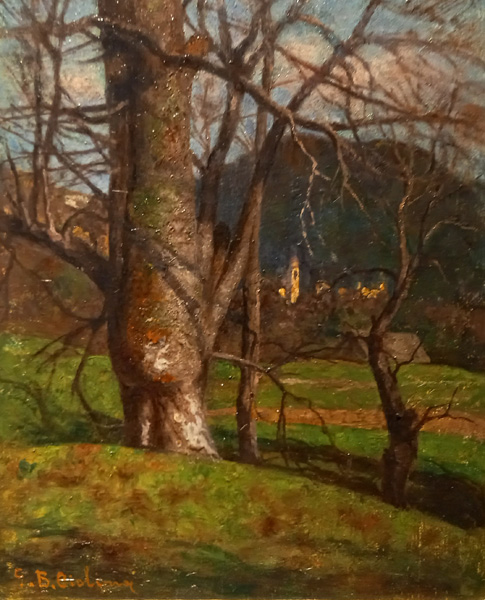
Castagno secolare (1940 ca.), Giovanni Battista Ciolina
Patriarca arboreo
Incentrato sulla robustezza del tronco più che sull’aprirsi dell’impalcato ramificato in controluce, il taglio compositivo di Ciolina esalta un secolare “patriarca” arboreo e la sua collocazione nel paesaggio vigezzino, un messaggio al tempo stesso di arte e realismo, archetipo spazio temporale di una “civiltà del castagno” che tanto ha segnato il paesaggio alpino (e non solo) inteso come spazio di vita. 9260 è il codice di “Natura 2000” che in tutta Europa identifica l’habitat dei boschi di Castanea sativa, che include i boschi misti con abbondante castagno e i castagneti d’impianto (da frutto e da legno) con sottobosco caratterizzato da una certa naturalità. Una duplice valenza, dunque, delle selve castanili: storico-culturale e naturale.
Una significatività dovuta alla persistenza storica dei castagneti da frutto, che per secoli hanno rappresentato la base economica ed alimentare delle popolazioni montane (l’arbul, vero e proprio “albero del pane”), ma anche del “saper fare” opere e manufatti che hanno concorso alla varietà dei paesaggi: le sistemazioni dei terreni a ciglionamento o a “lunette”, i terrazzamenti con muri a secco, i diversi “sesti di impianto”, manufatti quali edifici per essicatoi o mulini per la produzione di farina, legna da opera per tetti e compendi edilizi.
Allo stesso tempo le selve castanili, ed i castagni monumentali in particolare, si distinguono da altri ambienti agroforestali per la grande biodiversità animale e vegetale. Esse infatti si distinguono da altri tipi di bosco per diversi aspetti quali la vetustà delle singole piante, la struttura aperta dei popolamenti, l’ecomosaico di prati e selva, la rinaturalizzazione dei vecchi impianti produttivi con specie arboree, arbustive ed erbacee tipiche dei boschi naturali che i castagneti hanno sostituito per intervento antropico. Condizioni che favoriscono diversità di habitat e di micro-habitat fondamentali per l’ospitalità di specie anche rare di insetti, per la varietà di microfauna e specie ornitiche, e per la presenza di chirotteri.
Old Chestnut Tree (circa 1940), Giovanni Battista Ciolina
Arboreal Patriarch
Focused on the robustness of the trunk rather than on the opening of the branched scaffolding illuminated from behind, Ciolina's compositional style exalts a centuries-old arboreal "patriarch" and its location in the Vigezzo landscape, a message of art and realism at the same time, a space-time archetype of a "chestnut civilisation" that has significantly marked the Alpine landscape (and not only that) understood as a living space. 9260 is the "Natura 2000" code that throughout Europe identifies the habitat of Castanea sativa woods, which includes mixed woods with abundant chestnut and planted chestnut groves (for fruit and timber) with undergrowth characterised by a certain naturalness. There is therefore a dual value of the chestnut forests: historical-cultural and natural.
A significance due to the historical persistence of fruit-bearing chestnut groves, which for centuries have represented the economic and nutritional foundation of the mountain populations (the arbul, a true "bread tree"), but also of the "know-how" for creating works and artefacts which have contributed to the variety of landscapes: the arrangement of the land in embankments or "lunettes", the terraces with dry-stone walls, the various "plant spacing layouts", artefacts such as buildings for drying kilns or mills for the production of flour, wood for building roofs and building complexes.
At the same time, dense chestnut forests, and monumental chestnut trees in particular, stand out from other agroforestry environments for their great animal and plant biodiversity. In fact, they are distinct from other types of wood for various aspects such as the age of the individual plants, the open structure of the settlementss, the eco-mosaic pattern of meadows and forests, the re-naturalization of the old production plants with trees, shrubs and herbaceous species typical of natural forests which the chestnut trees have replaced due to human intervention. These conditions favour diversity of habitats and micro-habitats which are fundamental for hosting also rare species of insects, for the variety of microfauna and avian species, as well as for the presence of bats.

